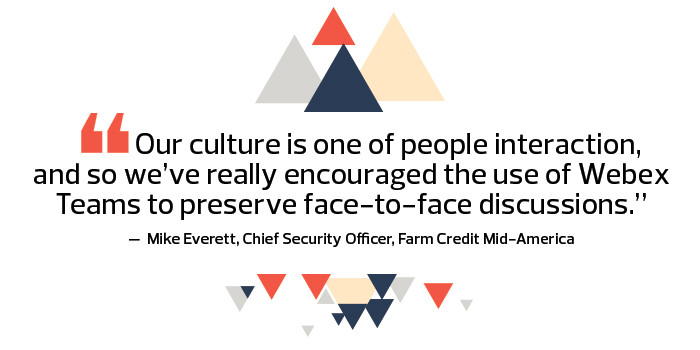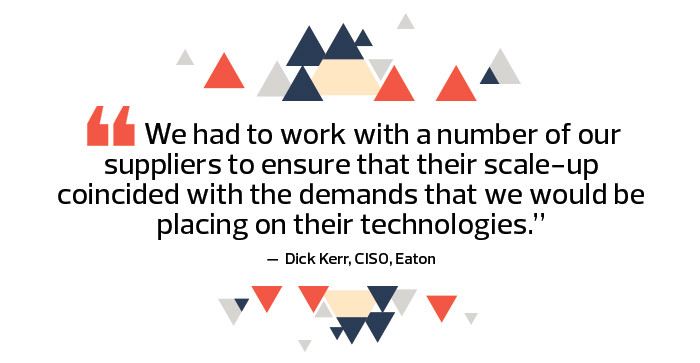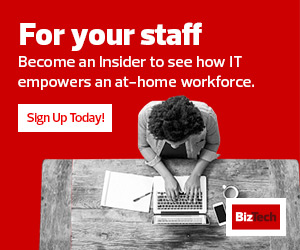It’s been called the world’s largest business continuity exercise. In March, the COVID-19 pandemic forced the closure of physical offices and forced thousands of businesses to support all-remote workforces for the first time, practically overnight.
This would have been nearly unthinkable just a few years ago. But with the right mix of solutions and some creative thinking, many companies were able to maintain or even increase employee productivity during a time of great upheaval.
BizTech brought together a panel of IT leaders to discuss how they met the tech and business challenges.
The roundtable included Mike Everett, vice president and chief security officer at agricultural lending cooperative Farm Credit Mid-America; Jim Fowler, executive vice president and CTO at insurer Nationwide; Dick Kerr, vice president of IT and CISO at power management company Eaton; and Josh Thurmer, IT director at fast-food chain Cousins Subs.
WATCH: Looking to bring part of your workforce back to the office? Follow these tips to do it safely.
BIZTECH: From a technology standpoint, how prepared were you when the crisis started?
Fowler: We realized during a disaster drill three years ago that our call center workforce wouldn’t have been prepared if we had sent them to work from home. So we spent about six months shoring up our infrastructure. Within five days after sending people home, we had everybody up and running, because we had done that planning and preparation. We had VPN technology, and then we were a heavy user of collaboration tools like Microsoft 365. Overnight, we tripled the number of virtual meetings, and the number of Teams and SharePoint sites has doubled.
Kerr: Eaton has a strong crisis response and business continuity planning practice in place. We already had a remote VPN capability and multifactor authentication. We also used collaboration tools, including Webex and the Microsoft Office 365 suite, along with remote end-user support capabilities.
Thurmer: We’re an Office 365 shop, so we use OneDrive and SharePoint, and we’ve started using those tools more during this time. Teams is a one-stop shop for collaboration among and within our departments.
Everett: We’ve relied on our VPN connection and Cisco Webex Teams, and everybody in the association has a laptop. We’ve been able to maintain the need to have that face-to-face interaction with the customers. Our culture is one of people interaction, and so we’ve really encouraged the use of Webex Teams to preserve face-to-face discussions.
BIZTECH: Were there any tools that you needed to add?
Thurmer: In response to the pandemic, we enabled curbside pickup for the first time. We needed to integrate our online ordering solution, our loyalty solution where our app is housed, our point-of-sale system and the front-end interface that our customers see on the website.
Fowler: We sell products primarily through independent agents and brokers, and we developed a product called Nationwide Express, which allowed them to drop a piece of code into their website that electronically quotes and binds our insurance products. In the first 30 days, over 700 agents across the U.S. took advantage of that as a way to keep their virtual front door open, even though their physical front door had to be closed.
Kerr: We certainly had to add scale. We had to work with a number of our suppliers to ensure that their scale-up coincided with the demands that we would be placing on their technologies.
Everett: We’ve doubled our connectivity to make sure that we can house and support the interactions and large meetings. We partnered with our carriers to increase our bandwidth.
BIZTECH: What were some of the greatest challenges you faced early on in the crisis, and how did you solve those problems?
Everett: It was really the education piece. We had specialty positions where people had never left their offices before, so they weren’t familiar with Webex Teams. We partnered with our internal organizational development and learning department to fast-track training.
Fowler: The first challenge was making sure everybody had the right level of network connectivity in their house. We spent a lot of time helping people get network upgrades for their homes so that they could actually function. Another challenge was paper mail. We implemented technology to scan mail coming into a physical mailroom, so we could virtually get that out to people instead of sending it to their physical office. That was something that we didn’t expect.
BIZTECH: What happened to employee productivity?
Kerr: There were quite a few worries about how productivity would shake out, but it’s been a welcome surprise to realize that productivity has not been tremendously impacted. We’re finding that it’s certainly feasible for a fair percentage of our workforce to work remotely and do so successfully and productively. I don’t think we recognized how feasible it really was until circumstances forced us to do it at a much quicker and larger scale than we previously had been doing.
Thurmer: We found that communication quality and quantity increased when everyone was remote, and that in turn created an increase in production. I know that seems counterintuitive, because if you all sit together you should talk together. But that didn’t seem to always be the case before.
Fowler: In our pandemic plan, we assumed that we would see a 30 to 40 percent reduction in productivity. In reality, we saw people working from home at or above their in-office level. That was an amazing thing for us. We worried about the fact that people were going to be home taking care of other people who might be ill, and we assumed that we would get less working time out of them. What surprised us is people gave us their commuting time, and they’re taking less vacation, so that’s a short-term boost. Another thing that we didn’t count on is that people aren’t going to all of the meetings that they used to attend, and they’re doing additional work during that time.
BIZTECH: How have you managed remote troubleshooting for end users?
Fowler: We already had a really strong service desk. We saw a spike in calls, and we added about 25 percent more staff out of the technology ranks on the team to help with general connectivity calls. Then, after that, we implemented a service depot. So in each of our major locations, we put a depot in place where, if an associate had a problem that we couldn’t solve remotely, they could drive up, drop off their computer, go grab a cup of coffee, and then drive back later and we’d have it fixed for them.
Kerr: Ten years ago, we implemented a global service center concept where, regardless of where you work, you have the ability to digitally, or via call, open tickets for support. So that’s the first line of defense for someone who needs help.
Thurmer: Ninety-five percent, or even more, of how we support our restaurants is remote support. COVID-19 didn’t change that at all.
Everett: We have a phenomenal service desk. Webex screen-to-screen sharing has been phenomenal, and Remote Desktop has also come in. If there’s something they can’t do, we ask them if they can go into the office and connect to the network and give us more visibility inside their laptop.
BIZTECH: From a tech perspective, what might change for your organization on the other side of this crisis?
Kerr: I suspect we’ll have more work from home than we had in the past. We’ve had flexible work practices in place for several years, but I think we had been perhaps slow to optimize on those. Many people are finding that this gives them better work/life balance, more flexibility, and yet they’re able to deliver on their commitments to the company. So I think we’re going to see more of that coming out of the pandemic.
Also, we’ve used augmented and virtual reality technologies during the pandemic to continue training and learning that otherwise would have been done face to face or hands-on. To the degree that we’re eventually able to travel again, we will do so less frequently for that sort of activity, saving travel costs and time.
Thurmer: Curbside pickup is something we didn’t talk about prior to COVID-19. Our customers have spoken by the sales numbers, and we will continue to head down that trail.
Fowler: We expect only about 50 percent of our workforce to ever come back to an office. We’re focusing on four core locations, and other than that, we’ve made the decision to close down all other physical locations around the United States. We always thought that we could have a smaller footprint from a real estate perspective, but we really proved out the ability to do it, do it at scale and do it with productivity.













